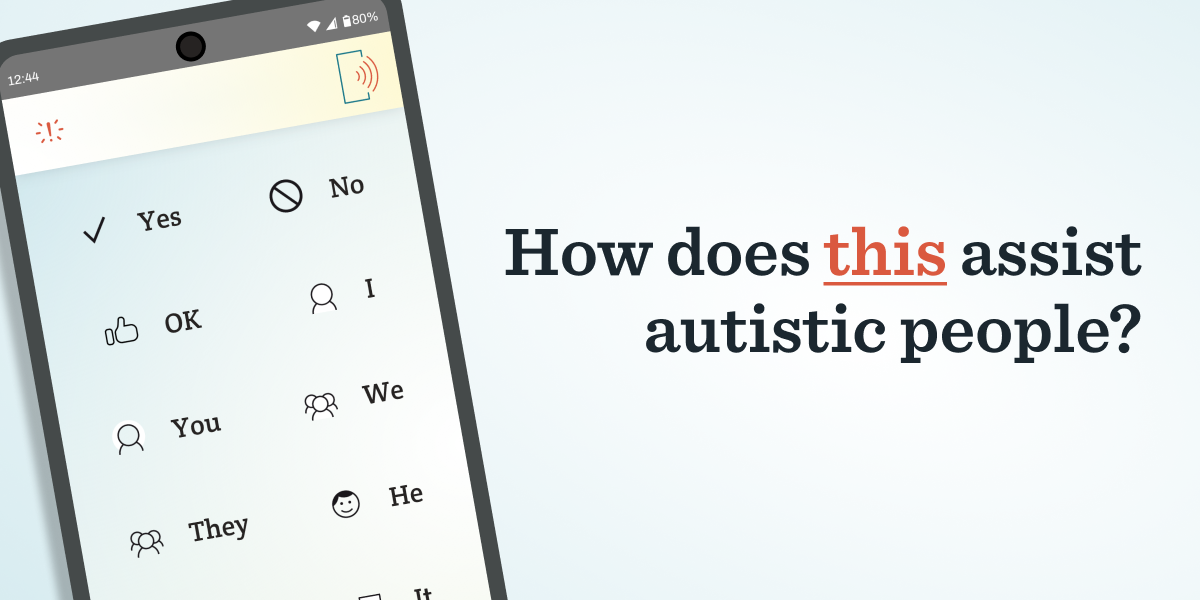The Connection Between AAC and Autism Explored

In today’s blog post, we discuss how Augmentative and Alternative Communication (AAC) empowers individuals on the autism spectrum and promotes inclusivity by breaking down communication barriers.
What Is Nonverbal Autism?
Nonverbal or nonspeaking autism, is a subtype of autism spectrum disorder in which individuals have significant challenges with verbal communication. This can range from temporary limitations on speech to the complete absence of it. Either way, it can present individuals with difficulties communicating their thoughts, needs, and emotions effectively.
It’s important to recognize that nonverbal autistic people are not incapable of communicating altogether. They simply rely on other forms of communication, such as gestures, facial expressions, or AAC to express themselves.
What Is AAC and How Does It Help?
We recently covered this topic in depth, but in short, AAC encompasses any techniques or tools designed to assist people that struggle with verbal communication. Nonverbal autism is just one of many reasons someone might use AAC.
For nonverbal autistic people, access to AAC can make a world of difference by breaking down the barriers preventing them from communicating their thoughts.
There are numerous advantages that AAC offers to nonverbal autistic individuals, such as:
- Enhancing Communication: AAC provides a means for nonverbal autistic individuals to express their wants, needs, thoughts, and emotions clearly and effectively. It bridges the communication gap and reduces frustration, leading to increased independence and self-advocacy.
- Promoting Social Interaction and Inclusion: By facilitating communication, AAC fosters social interactions and meaningful connections with others. It encourages participation in social activities, strengthens relationships, and reduces feelings of isolation.
- Allowing Self-Expression: AAC not only enables individuals with nonverbal autism to express their immediate needs and desires but also serves as a powerful tool for self-expression. Through AAC, individuals can more easily share their unique perspectives, creativity and inner world with others.
- Facilitating Education and Learning: In a similar fashion, AAC tools can be integrated into educational settings to make participation in learning activities much easier by allowing affected individuals to engage with their peers and teachers.
- Supporting Language Development: AAC interventions can support language acquisition and development. Through exposure to visual symbols, vocabulary expansion, and structured communication opportunities, AAC helps individuals build their linguistic skills.
Our own app, Spoken, is one of the most popular free AAC apps for nonverbal communication. We’re proud that we’re able to help people on the spectrum feel more included and communicate their thoughts and emotions.
AAC as a Choice
Back in February 2023, we shared an insightful ASHA Voices episode, which revealed that some autistic adults choose AAC despite oral communication being an option for them. Even when nonverbal autism only minimally affects an individual, speaking can still become frustrating and tiresome. This sort of burnout can reduce participation in conversation and harm one’s ability to self-advocate. Due to this, it’s important to recognize AAC as a legitimate alternative to speech. Pushing for something that brings the communicator discomfort is likely to have a negative impact. Thus, if AAC access encourages its user to participate in communication, we should advocate for its use.
For more about the negative impact of taking away AAC access or stigmatizing its use, check out this study conducted using participatory research. It features testimonials from autistic adults who have been placed in situations where AAC use was discouraged or limited, in which they explain how it has affected their lives.
There was a time when finding access to AAC may have been difficult for someone that doesn’t expressly need it, but these days there are many free apps for nonverbal autism, such as our own. Rather than needing expensive, dedicated AAC devices for autism, one can simply use their existing mobile phone or tablet to make communication easier and more comfortable.
We also think it’s important to highlight how recent advancements in AAC technology blur the lines between AAC use and oral communication. Apps like Spoken offer natural-sounding and customizable voices, which eliminates the disparity between AAC use and traditional speech. Hopefully, technological improvements like these will continue to reduce the stigmatization of nonverbal communication and allow for greater promotion of AAC use when applicable.
Final Thoughts
AAC plays a crucial role in empowering individuals on the autism spectrum—particularly those with nonverbal autism—by breaking down communication barriers. AAC provides a means for nonverbal autistic individuals to express themselves clearly and effectively, enhancing their communication skills and promoting their independence and self-advocacy. Furthermore, AAC fosters social interaction, inclusion, and meaningful connections, while also facilitating education, learning, and language development. It is essential to recognize AAC as a legitimate alternative to speech and advocate for its use when it encourages individuals to participate in communication. With the availability of free communication apps like Spoken and technological advancements that bridge the gap between AAC use and oral communication, we can strive for a more inclusive and accepting society that values and supports the communication needs of all individuals.
Update: If you’d like to read more about AAC as a choice, we later penned the blog AAC Isn’t a Last Resort: Choosing to Use AAC Instead of Speech
About Spoken
Spoken is an app that helps people with aphasia, nonverbal autism, and other speech and language disorders.
